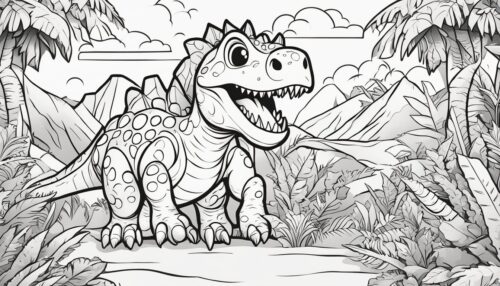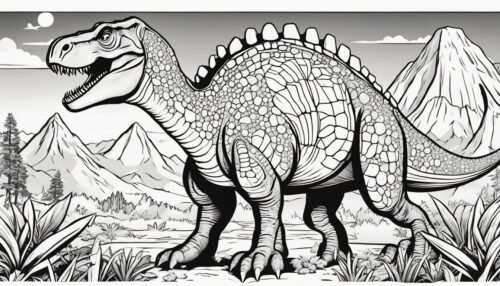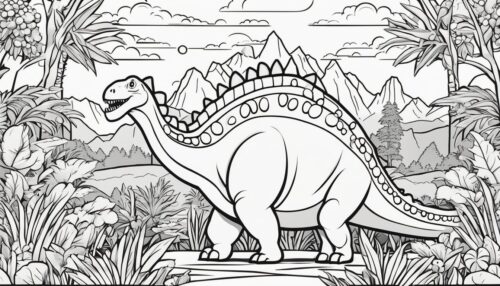Pictures to Color Dinosaurs: Fun and Educational Coloring Pages. If you’re on the lookout for engaging activities that combine fun and learning, dinosaur coloring pages are a fantastic option. These pages help children immerse themselves in the fascinating world of dinosaurs, from the towering T-Rex to the gentle Brachiosaurus. Not only do dinosaur coloring pages entertain, but they also aid in developing creativity, concentration, and motor skills.
Pictures to Color Dinosaurs




Parents and educators will find a wealth of resources available online. Websites like Supercoloring offer an extensive selection of dinosaur-themed coloring pages, catering to various interests and age groups. Similarly, ColoringPagesOnly provides over 900 downloadable sheets that can keep kids captivated for hours, enhancing their color recognition and detail-oriented skills.
For those looking to keep kids busy on a rainy day or during indoor playtime, pages from Mom Loves Best and Monday Mandala present a perfect blend of entertainment and education. Each page features a unique dinosaur, allowing kids to learn about these ancient creatures as they color.
The Science of Dinosaurs



Analyzing the fascinating world of dinosaurs involves understanding distinct species, the field of paleontology, and the evolutionary journey of these ancient creatures from millions of years ago through the Mesozoic era.
Understanding Dinosaur Species
Dinosaurs are classified into various species based on unique characteristics such as their skeletal structure, size, and dietary habits. Significant groups include the Theropods like Tyrannosaurus rex, known for their ferocious nature and large carnivorous tendencies.
Sauropods, such as Apatosaurus and Brachiosaurus, are recognizable by their enormous sizes and long necks, primarily feeding on plants. Ornithischians, a diverse group, include species like Triceratops and Stegosaurus, characterized by their herbivorous diet and distinct body armor.
Pictures to Color Dinosaurs. Categorization helps paleontologists better understand their lifestyle, behavior, and role in the prehistoric ecosystem.
Paleontology and the Prehistoric World




Paleontology, the study of ancient life through fossils, is crucial for exploring the prehistoric world where dinosaurs roamed. Fossils provide critical insights into the physical structure, habitats, and potential reasons for the extinction of these creatures.
By excavating and analyzing fossils, scientists reconstruct ancient environments from millions of years ago, offering glimpses into the Mesozoic era. Techniques such as carbon dating enable accurate estimation of fossil age, while advanced imaging technology allows detailed study without damaging samples.
Continued discoveries and research in paleontology enrich our understanding of how dinosaurs interacted with their environment and other species.
Evolution of Dinosaurs Through Millions of Years
Dinosaurs evolved over millions of years through the Triassic, Jurassic, and Cretaceous periods, collectively known as the Mesozoic era. Initially small and bipedal, early dinosaurs diversified considerably in size, shape, and function.
Pictures to Color Dinosaurs. The Triassic period marked the emergence of the first dinosaurs. The Jurassic period witnessed significant diversification, with iconic giants like Diplodocus roaming the earth. In the Cretaceous period, many well-known species such as Velociraptor and Triceratops appeared, leading up to the mass extinction event.
Understanding these evolutionary changes reveals how dinosaurs adapted to various ecological niches, highlighting their resilience and adaptability in a constantly evolving prehistoric world.
Dinosaur Habitats and Diets – Pictures to Color Dinosaurs




Dinosaurs roamed a variety of habitats, from dense forests to arid deserts, adapted to their surroundings. Their diets were as diverse as their environments, with some specializing in meat and others in plants.
Carnivores and Herbivores of the Dinosaur Era
Carnivores like the fierce T-Rex, Velociraptor, and Carnotaurus primarily hunted other dinosaurs and small animals. These predators had sharp teeth and claws to catch and devour their prey. The T-Rex, for example, possessed strong jaws capable of crushing bones, making it one of the most formidable hunters of its time.
On the other hand, herbivores such as the Brachiosaurus and Triceratops fed on plants. The Brachiosaurus, with its long neck, could reach high vegetation, while the Triceratops used its beak-like mouth to munch on low-lying shrubs. These plant-eaters often lived in herds, providing them with safety in numbers against carnivores.
Famous Dinosaur Habitats
Dinosaur habitats ranged from lush forests to vast deserts. Forests offered abundant food and shelter for herbivores like the Brachiosaurus and Triceratops. In contrast, carnivores like the Spinosaurus preferred wetlands and riverbanks, which provided ample fishing opportunities.
Deserts housed dinosaurs adapted to harsh conditions, such as the Dilophosaurus. Coastal areas and swamps supported a mix of carnivores and herbivores, each finding their niche. These specific environments shaped the evolution and survival strategies of each dinosaur species, reflecting their diverse lifestyles and diets.
Popular Pictures to Color Dinosaurs



Dinosaurs captivate the imagination with their sheer size and diversity. Most notably, the Tyrannosaurus Rex and Velociraptor are renowned for their predatory prowess, while herbivores like Brachiosaurus, Diplodocus, Stegosaurus, and Triceratops bring balance to the prehistoric landscape.
Tyrannosaurus Rex
The Tyrannosaurus Rex, commonly known as T-Rex, stands out due to its massive size and powerful jaws. This apex predator roamed the late Cretaceous period around 68 to 66 million years ago. Measuring up to 40 feet in length and weighing around 9 tons, the T-Rex had an impressive bite force, capable of crushing bone.
Key Features:
- Height: About 12 feet at the hips
- Diet: Carnivorous
- Distinct Traits: Tiny arms, massive skull, and sharp, serrated teeth
The T-Rex’s keen sense of smell and vision made it a formidable hunter, often depicted as the king of dinosaurs in popular culture.
Velociraptor
Pictures to Color Dinosaurs. Velociraptors gained widespread fame through movies, but the real species was quite different from their on-screen depiction. They lived during the late Cretaceous period and were much smaller, measuring about 6 feet long and weighing up to 33 pounds.
Key Features:
- Height: Around 2 feet at the hips
- Diet: Carnivorous
- Distinct Traits: Sickle-shaped claws, agile body, likely feathered
With their speed and agility, Velociraptors were skilled hunters, often believed to hunt in packs. Their intelligence and coordination added to their hunting prowess, making them effective predators.
Brachiosaurus and Diplodocus



Brachiosaurus and Diplodocus were enormous herbivores known for their distinct body shapes and long necks. Brachiosaurus had a distinctively high shoulder and longer front legs.
Key Features of Brachiosaurus:
- Height: Up to 40-50 feet
- Diet: Herbivorous
- Distinct Traits: Long neck, large nostrils on top of its head
Diplodocus, on the other hand, had a lengthy whip-like tail and was one of the longest dinosaurs, measuring up to 90 feet from head to tail.
Key Features of Diplodocus:
- Height: Approximately 15 feet at the hips
- Diet: Herbivorous
- Distinct Traits: Extremely long tail and neck, peg-like teeth
Both species thrived during the late Jurassic period, showcasing the diverse adaptation of herbivores.
Stegosaurus and Triceratops
Pictures to Color Dinosaurs. Stegosaurus and Triceratops are well-known for their unique body armor and defensive adaptations. Stegosaurus, recognizable by its double row of large, bony plates along its back, lived during the late Jurassic period.
Key Features of Stegosaurus:
- Height: Around 9 feet at the hips
- Diet: Herbivorous
- Distinct Traits: Plates along the back, spiked tail
Triceratops, on the other hand, had three prominent facial horns and a large bony frill, providing defense against predators like T-Rex.
Key Features of Triceratops:
- Height: About 10 feet at the hips
- Diet: Herbivorous
- Distinct Traits: Three facial horns, large frill
Both these herbivores demonstrated the evolutionary adaptations that allowed dinosaurs to thrive in diverse environments.
Dinosaur-Inspired Activities




Dinosaur-inspired activities can engage children in both educational and creative ways. These activities help develop fine motor skills and foster confidence and creativity, making them ideal for young dinosaur enthusiasts.
Coloring as an Educational Tool
Coloring dinosaur pages can be an effective educational tool. Children can learn about different species, their habitats, and behaviors. For example, coloring a page of a T-Rex in a prehistoric forest can stimulate curiosity about the Jurassic period.
Teachers and parents can use these opportunities to discuss paleontology and the evolutionary history of these fascinating creatures. This approach makes learning interactive and enjoyable, ensuring children retain information better while having fun.
Moreover, incorporating labels and small descriptions on coloring pages can further enhance vocabulary and reading skills. By associating the image with a name, children can more easily remember and recognize various dinosaurs.
Fostering Creativity and Fine Motor Skills
Pictures to Color Dinosaurs. Coloring not only fosters creativity but also hones fine motor skills. As children carefully color within the lines and select different colors, they refine their hand-eye coordination and precision.
Encouraging kids to use their imagination when coloring dinosaurs can enhance creativity. They might choose non-traditional colors or add unique backgrounds, expanding their creative thinking. For dinosaur enthusiasts, this can also be a relaxing activity that builds confidence as they see their artistic abilities grow.
Using different mediums such as crayons, markers, or colored pencils can provide varying textures and effects, further stimulating their sensory development. Additionally, cutting out colored dinosaur figures can transform a simple coloring task into a multi-step project, adding an element of craft to the activity.



